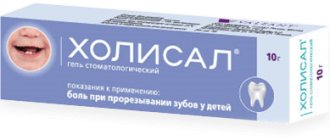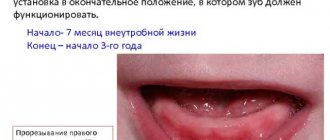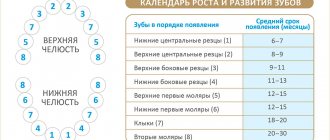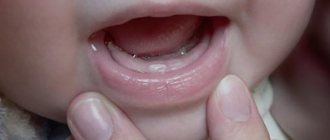What causes fever to rise during teething?
Contrary to the popular belief of parents, an increase in temperature on the teeth is not the norm and does not always accompany teething. In this way, the baby’s fragile body responds to the occurrence of an inflammatory reaction in the gum, through which the first tooth makes its way. In this place, immune defense is reduced, microorganisms living on the mucous membranes are activated - this also provokes temperature surges.
This process is most difficult after a year, when fangs or molars are being cut, since the chewing teeth have several tubercles that cannot appear simultaneously and the process sometimes drags on for up to several weeks. The “eye” teeth are located slightly deeper than the others and must travel a longer path to the gum surface. Therefore, children usually experience quite severe discomfort and prolonged rises in temperature when they appear.
Sometimes fever during this period of life is a sign of an acute infection, which is due to reduced immunity. In this case, the body tries to protect itself from the invasion of viruses or bacteria and increases the temperature, which is destructive for pathogens.
What is the maximum temperature possible during this period?
How much the temperature rises when a baby’s teeth appear depends only on his individual characteristics. On average, this figure is 37.5-37.7 degrees. Sometimes this figure can reach 38 - this is also an acceptable value. It is important to take regular measurements, since infants do not regulate heat exchange well and as inflammation progresses, the temperature can increase very quickly.
A higher temperature (39-40 degrees) may indicate complications, the development of a respiratory tract infection and requires immediate medical attention.
How many days does it last
In answering this question, it should again be recalled that all children are different and react differently to the appearance of teeth. On average, fever in babies can last 1-3 days and usually disappears immediately after teething.
But in the experience of many pediatricians, there are children whose high body temperature associated with the appearance of their first teeth lasted up to 4-5 days. Or there are cases when the fever lasts only a few hours and goes away without any intervention. In any case, you should not delay consulting a doctor, since if you have any diseases, identifying them earlier has a more favorable outcome.
How many days does a baby's fever last during teething?
Typically, fever during teething lasts for 1 to 3 days.
On the 4th day, the temperature should begin to subside. If the process takes longer, be sure to invite your treating pediatrician. This is necessary to accurately determine the cause of the fever. Many parents believe that a temperature of 38 - 39 degrees is normal when the first teeth appear, but in fact, the baby develops some kind of infection along with the teeth. The pediatrician diagnoses the cause of fever and malaise.
Don’t be afraid to be suspicious and overly anxious; invite a specialist on the very first day of high fever. Don't risk your baby's health.
Other symptoms accompanying fever
During teething, there may be other symptoms in addition to fever. Swelling of the gums can spread from the oral cavity to the nasal mucosa, thereby causing a slight runny nose and the discharge of a slight transparent mucous secretion. This symptom is more pronounced when the upper teeth erupt.
The appearance of baby teeth is often accompanied by excessive salivation, especially when the lower teeth erupt. This also causes a slight loosening of the stool - the stool becomes a little softer than usual.
What should parents be wary of?
A child's body, weakened by teething, is very susceptible to bacterial or viral infection. Therefore, the baby’s symptoms may indicate complications:
- Severe nasal congestion , accompanied by copious discharge of purulent secretion. This suggests that on top of the usual swelling of the mucous membrane there is rhinitis, which must be treated.
- Loose stools . Fever and diarrhea together rarely accompany the appearance of teeth. This symptom may indicate the presence of some kind of intestinal infection, which the child could have introduced into the body with toys or gum teethers.
- Cough . With excessive salivation, children do not always have time to swallow saliva in time and sometimes choke on it, which causes periodic coughing. If the cough is systematic, accompanied by difficulty breathing or sputum discharge, then this speaks in favor of inflammation of the respiratory tract.
- Red throat . The inflammatory reaction that occurs in the gums during teething cannot spread to the mucous membranes of the throat. Redness of the palatine arches or pharynx is a sign of pharyngitis or acute respiratory infections.
- Vomiting often accompanies high body temperature in young children. But it may be a sign of damage to the nervous system or intestinal infection.
The presence of such signs requires urgent medical attention and appropriate treatment, regardless of what temperature (high or low) accompanies them.
Temperature during loss of primary teeth and eruption of permanent teeth
The replacement of baby teeth with molars is usually not accompanied by any temperature reactions. An exception may be chewing teeth, which have a large surface and cause significant inflammatory reactions in the gums.
In addition, an increase in temperature during teething in a fairly old child (6 years of age or more) may indicate the presence of gingivitis - a disease of the gingival mucosa, which can lead to serious consequences without treatment.
Why do babies have a fever when teething?
Before a tooth is visually visible to us, it goes through a certain path: first through the bone tissue, and then through the gum.
The process itself is quite painful for the baby, the gums itch and swell. An inflamed area forms in the tooth eruption area, and the baby’s immunity sharply decreases. Against this background, the child experiences an increase in temperature. During the period when the first teeth appear, the baby begins to salivate profusely. This is how the child’s body turns on natural protection against possible infection during an active inflammatory process. Saliva, in composition, is a natural anti-inflammatory agent, abundantly washing the baby’s gums.
The baby's teething temperature is usually 37 - 37.7 degrees. There is no point in fighting such a temperature; the body has turned on its protective functions. Your task is to carefully monitor the condition of the baby so that the temperature does not exceed 38 degrees, do not wrap the child up again. There are situations when the baby’s temperature reaches 38-39 degrees.
It is important to monitor the thermometer readings every hour, especially in the evening the temperature can rise sharply. If antipyretic drugs and rubbing do not help, that is, an hour has passed after using the product, and the temperature has not dropped even by 1-2 degrees, then immediately call a doctor. And at temperatures above 39.2 degrees, it is better to immediately call emergency services.
What to do when the temperature rises
Often parents, even with a slight fever, begin to actively treat the child with antiviral, antipyretic and antibacterial drugs. Even if this symptom is due to the appearance of the first teeth. Most pediatricians (including Dr. Komarovsky) are against such radical methods. Why shouldn't you do this?
A temperature of 37 degrees and above is a kind of protective reaction of the body and helps it more actively produce antibodies against viruses and bacteria. Low body temperature does not allow you to effectively fight infection. Therefore, sometimes it is worth not interfering with natural processes and immediately suppressing even minor signs of fever.
But you shouldn’t fall into inaction either. If the fever reaches significant numbers (38 degrees or higher) and is accompanied by a change in the general condition of the child, then prescribing antipyretic drugs for high fever is a primary measure.
If the rise in temperature is not controlled by conventional medications, then it is possible to scrub the child with cool water or an vinegar-alcohol mixture.
If the fever does not subside within 3 days, then you must definitely visit your treating pediatrician to decide on further examination and the possibility of prescribing antibiotics or other medications.
Some parents prefer homeopathy in such cases. Such drugs do not effectively reduce the temperature, but they can alleviate the baby’s general condition and speed up the recovery process. A prerequisite before taking homeopathic medicines is to consult a specialist.
Go for a walk!
WHY DO YOU NEED TO WALK?
Purely theoretically, all parents understand that walks mean fresh air and health, but let’s look at what getting out of a warm apartment or house gives us. By and large, any walk is contact with nature (if, of course, you are not walking along busy streets, but at least in a park) and an attempt to get away a little from the harmful factors of civilization. What does it mean? Every city apartment (and country house too) accumulates a huge amount of harmful substances. First of all, this is dust and a variety of allergens (particles of household chemicals, varnishes, paints), which are always present in furniture, books, carpets and in general in any objects in our home. Plus all the street trash that flies through the windows if it’s a city apartment. But there is no or very little fresh air in our homes, because in winter it is difficult to keep the windows open and constantly ventilate the room. There is also no sunlight in our homes - useful UV radiation, which is necessary for the growth of all living things. And finally, sitting at home, we sharply limit our physical activity. Therefore, it is clear that everyone, including children, needs to go out into the fresh air and take a walk. Of course, walking in summer is more pleasant than in winter: it’s warm, the birds are singing, the grass is turning green, the flowers are blooming, and somehow it immediately becomes clear that walking is both pleasant and useful. What about in winter? Cold, snow, monotonous landscape - all this is uncomfortable, so where is the benefit of winter walks?
WHAT WILL A WINTER WALK GIVE A CHILD:
1. Health.
In cold weather, the air becomes cleaner and richer in oxygen, and all dust is trapped by snow. Fresh air will clear the lungs of everything that the baby inhales in the apartment, the mucous membranes of the respiratory tract will begin to work better, and the blood and, accordingly, all organs will be enriched with oxygen. While walking, the child will grow and develop physically better.
2. Hardening.
The air temperature during a walk in winter is significantly different from the air temperature in the room - all this will harden the baby’s body.
3. Vitamin D
In winter there is very little sun and a walk is the only opportunity for a child to get a “portion” of ultraviolet radiation. Namely, under its influence, our body produces vitamin D, which is necessary for the prevention of rickets. Of course, to prevent rickets, you will need to do more than just walk, but it’s still worth using this simple and natural “cure.”
4. Physical activity.
Walking in winter, when we are wearing a lot of clothes, especially if we move actively, we spend more effort and energy. The baby also spends it, even if he just moves his legs along the road, digs snow, rolls over a snowdrift, or slides down a hill with his parents. So a winter walk, willy-nilly, gives us physical activity, and this, in turn, stimulates the functioning of the cardiovascular and immune systems. It turns out that there are again health benefits.
5. Development and socialization.
On the street the world is completely different than in a child’s usual apartment or house. It’s full of all sorts of amazing things for children: it’s snowing or the sun is shining, a dog is running, a crow is cawing, a car is passing by. Moreover, all this changes very quickly: the baby constantly sees a new picture and receives new information, studies the properties of different objects. While walking, children learn to establish different connections: a dog barks, a bird flies, and the snow is white and beautiful. Plus communication with other children and new contacts. Well, yes, in the warm season there is more street entertainment, but don’t sit in your apartment until the snow melts!
Of course, not all of these factors will work on every walk: the sun does not always shine, and as for infants, they often sleep outside and have no movement or special familiarization with the outside world. But winter walks definitely provide health and strengthening, if, of course, you walk in the fresh air, and not along polluted streets or shops full of people.
WHY DON'T THEY WALK?
True, no matter how much they talk about the benefits of winter walks, still at this time of year many mothers and fathers with their children do not walk or walk rarely or for a short time. Adults understand that this is wrong, but the reasons for staying at home seem convincing to them. What parents tell themselves:
The child will get sick in the cold.
This is a typical horror story that mothers and grandmothers especially love: they say that a child will breathe in the air in the cold and he will start to cough, runny nose or have a sore throat
.
But cold air does not cause illness - this is a myth.
In fact.
A person gets sick from bacteria or viruses, not from cold. On the contrary, many viruses die in the cold, so walking at sub-zero temperatures is safer than at above-zero temperatures. Another thing is that hypothermia (frozen feet, for example) can cause a virus or microbe that has entered the body to begin to develop. Well, you just shouldn’t allow it (hypothermia).
There are only infections on the street
. Now that we have been bombarded with a flood of all kinds of negative information, in particular about all sorts of viruses and diseases, many anxious mothers are generally afraid to go outside with their small children again. Especially in the first weeks and even months after birth if the child was born in the fall and winter. It is believed that a baby might be sneezed on on the street, or a virus could be left behind in a hallway by a sick person, and the child would catch it. Endless media horror stories about new and terrible strains of influenza, daily news about severe complications from illnesses and other horror stories only add fuel to the fire. So mothers and children sit at home all winter and only walk on the balcony.
In fact.
An apartment will not protect against diseases—a father, grandmother, or mother herself can bring a virus into the house: a family does not live in complete isolation from the world. But a walk in the fresh air, on the contrary, will strengthen your health and immunity.
Walking in winter is so difficult and boring.
In winter, you need to dress for a long time: first yourself, and then dress your child in several layers of clothes. Moreover, you need to dress for the weather, otherwise you will quickly freeze and have to return. The question arises: why did they go out at all? And you also have to not forget anything (the same mittens), otherwise, again, you have to return home, and this is always inconvenient with a small child. In addition, many babies do not tolerate the process of dressing well: they scream so much that it is easier to skip the walk and stay at home. It’s cold in winter, you can’t sit on a bench with a stroller, you can’t read a book, you have to walk all the time. Plus, many parents are generally bored of walking with a stroller or hand in hand with a child, even if the weather is good and the baby is calm.
In fact.
These are all excuses and plain laziness. Today there are so many high-tech and comfortable clothes (for both adults and children) that dressing for a walk can be easy and comfortable. Children very quickly get used to the process of dressing or simply resign themselves to it. If you try a little, you can find something interesting even while walking with a stroller (listen to audiobooks, music, communicate in the company of other mothers).
The child will freeze or, conversely, overheat
. In winter, you need to put a lot of clothes on the baby, but it’s difficult to understand exactly whether the feet are cold or, on the contrary, whether the baby has mated.
In fact
. Usually parents dress the child so warmly that he definitely does not freeze. Even if the baby is lying in a stroller, you can always feel his arms and legs and determine if they are cold. Much more often, a child feels hot during a walk, and you can tell about this by his appearance and behavior. The baby's face turns red, he begins to worry (is naughty or cries), and asks for a drink. Then you need to put your hand behind the baby’s collar and feel his back (if it is sweating).
The child will want to eat, but in winter you won’t be able to breastfeed outside
. Therefore, it’s better not to go out for a walk, especially since if you go out, you won’t be gone for long anyway.
In fact
. You can feed the baby before the walk. Then you are guaranteed to have 1–1.5 hours to go outside and get some fresh air. And this is quite enough for a winter walk. In general, children fall asleep quickly outside in winter and then sleep for a very long time. So there is usually enough time to walk between feedings.
Bad weather in winter
– if not a snowstorm, then ice, if not frost, then slush.
In fact.
Bad weather in winter, unless a person lives in really difficult climatic conditions, still happens infrequently. Snowstorms do not blow all winter, and severe cold is replaced by light and pleasant frost, so most often the same parental laziness is hidden under the words “bad weather”. Or the lack of habits for a healthy lifestyle and walking in particular. Plus, at home we are anchored by the usual comforts: a soft sofa, a TV, a computer.
It turns out that there are no particularly serious reasons not to walk with your child in winter. But here, too, we must observe moderation. There is no need to perform heroic deeds or go for a walk in the name of your baby’s health if you don’t have the strength, food isn’t ready for yourself or your husband, the weather is bad outside, or something just went wrong today. Nothing bad will happen if the child stays at home for one or even a couple of days. But as soon as the weather gets better and you have strength, you need to go outside. What about the balcony? To be honest, everyone understands that a walk on the balcony is not the same as a walk in the park or forest. This is a solution for those who live in a house without an elevator, who don’t have at least a public garden nearby, if it’s very cold and bad weather outside, if their mother doesn’t feel well or is very busy with household chores or work.
GOING OUTSIDE
When to start.
If a child was born in winter or cold spring or autumn, then in the first days after birth he does not need to go for a walk. And not only because it’s cold outside, the baby just needs to first adapt to the outside world, both he and the mother need to enter a new rhythm of life. In general, pediatricians have different opinions about when to start walking with a newborn. Some doctors believe that a healthy child can be taken outside in the winter within a week after birth, others recommend walks from the 10th to 14th day of life, while others generally advise waiting until three to four weeks. Here you will need to look at everything: the child’s weight (underweight children are advised to start going out later in winter), his condition, the weather, the family’s capabilities (the mother may not have the strength, the father works, and there are no grandmothers nearby).
At what temperature and for how long to walk.
Here you also need to pay attention to the weather. Doctors recommend taking a newborn out for the first walk if the temperature outside is not lower than minus 5 ºС. At first, you don’t even have to go outside, but take a “walk” with your dressed baby in a room with a wide open window or sit on the balcony. Then leave the house with the baby holding him in your arms, and then take a walk in the stroller.
Every day the walk is increased by about 5–10 minutes, and it turns out that after going outside on average 10 days, by the month the child can already walk for an hour, and then 1.5–2 hours. But here again we need to look at the climate. It may be 0 ºС or even plus outside, but a strong north wind will blow - walking in such weather is unpleasant and unnecessary. Or maybe the frost is below minus 15 ºС, and the day is sunny, the weather is mild - then the numbers on the thermometer will not interfere with a walk in the fresh air.
How to dress a child
. As mentioned earlier, everything is simple with clothes now. Woolen leggings that still need to be pulled on, numerous scarves under a hat, heavy children's fur coats, just socks and second socks on top, scarves to stop the wind, and other grandmother's tricks for warmth are a thing of the past. It's simple: a child is walking in a stroller - a cotton overall (slip) to the body, a fleece one on top, and then an overall or envelope with insulation. A cotton helmet is placed on your head, and a wool or fleece helmet is placed on top of it (or you can wear a “2 in 1” helmet). Socks on your feet, mittens on your hands. If you are very scared, take a blanket (just in case). If the child is already walking, everything is the same, but instead of an envelope there will already be overalls and plus winter children's shoes. And no extra buttons, ties or anything else that irritates both mother and child. Slips with convenient buttons, overalls (envelopes) with a zipper, instead of a stuffy scarf, a helmet hat will cover your neck, scratchy wool has been replaced with soft and pleasant fleece - you can get ready for a walk in such comfortable clothes, like in the army, in a few minutes! Before you go out for a walk, you must first collect all the necessary things (napkins, pacifiers, toys), then get dressed yourself, and last but not least, dress the child (otherwise he will quickly get hot).
As you can see, walking in winter is not difficult and even very useful. So dress right and get going.
–
towards nature and health!
Is it possible to walk with a child with a fever?
If the baby’s general condition does not suffer much during teething, and the temperature is not high and is well controlled by antipyretic drugs, then a walk may even be beneficial. The main thing is to dress your child according to the weather, try to stay away from other children (since you can easily catch an infection) and not tire your baby with active outdoor games.
If the fever reaches high levels and the child does not tolerate it well, then it is better to refuse a walk until the condition improves.
In any case, even if parents are sure that the increase in temperature is caused by teething, medical consultation is necessary. You should not self-medicate, since incorrect measures will not only not alleviate the baby’s condition, but can also harm his health.
Before you get vaccinated
Taking into account the fact that in the vast majority of cases, vaccinations are well tolerated by healthy children without any preparation or pre-treatment, the most important point in preparing a child for vaccination is to determine contraindications to vaccinations, that is, those cases of illness in a child in which vaccination can give serious adverse reactions. Contraindications and precautions for vaccination; in some cases, vaccination in children is either strictly prohibited or should be postponed to a later date. In order to correctly assess contraindications and precautions for vaccination in a child, it is important to follow the vaccination calendar and know in advance which vaccination should be given to the child and when. Before vaccinating your child and on the day of vaccination, read what contraindications and precautions are associated with the administration of a particular vaccination and make sure that the child does not have any contraindications for the vaccination. If you find it difficult to determine certain contraindications or precautions (for example, how dangerous a child’s cold or cough is), show it to your doctor. You should not blindly refuse vaccination because of a slight runny nose or cough - this will only disrupt the vaccination plan.











